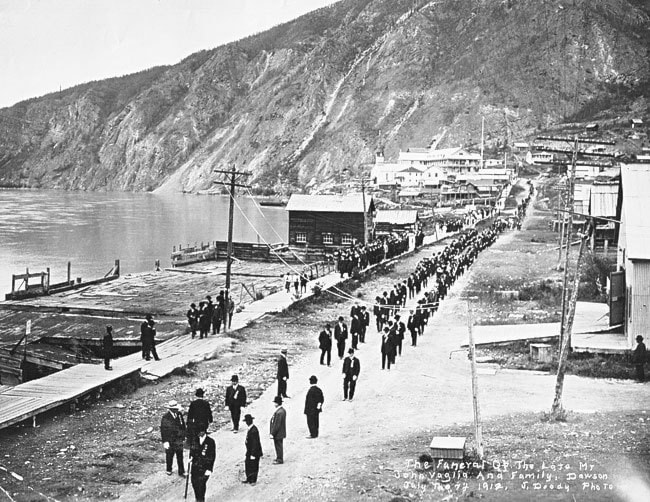Mass murder isn’t new, even in the Yukon.
The morning calm of July 4, 1912 was disturbed at 9:05 a.m. by what at first sounded like firecrackers, coming from the second floor of the Central Hotel in Dawson City. Within moments of silence having fallen after the last shot rang out, several men on the premises cautiously went to investigate. They found a grisly scene.
Mrs. Camille Vaglio, the wife of the proprietor of the Central, was found first, fully dressed, lying face down in her bedroom. A bullet wound and stab wounds to the chest revealed the nature of her demise.
Next, the horrified investigators found 55 year-old John Vaglio, the husband, lying in bed with the covers thrown back. The appearance suggested that he had been awakened by the initial ruckus, and was starting to get out of bed when he met his end. He lay lifelessly in a dark red pool of blood with six bullet holes, one in the groin, one in the chest, and four in the head.
They moved on to find the older daughter, Rosena, or Rosa, who was still lying in bed. Four bullet wounds in both arms suggest that she tried to protect herself. A mortal fifth bullet had penetrated her 16-year-old heart. She too had received multiple stab wounds.
The second Vaglio daughter, Christina, and the youngest victim at nine years of age lay on the floor at the foot of her bed with a bullet wound in the hip and another in the forehead above her right eye. She had also received a single superficial knife wound to the scalp.
At the foot of the girls’ bed lay Eugene Vaglio, Camille’s brother, on his back, wearing a dark suit and a bow tie. Eugene exhibited several shallow stab wounds to the chest and throat, and a bullet hole that had penetrated his brain through his lower jaw. Near his body were three handguns, including a Colt automatic and a bloody knife.
The Mounted Police were immediately summoned, and after an initial inspection of the scene, “Captain” Horrigan set up a coroner’s inquiry. After the victims were examined by Doctor Culbertson and Dr. W.E. Thompson, they were declared dead, and the scene of the crime then lay undisturbed so that it could be examined by the police.
Two hours later, at two o’clock in the afternoon, with a speed that would be unthinkable in today’s court system, a coroner’s inquest was called to order, and the testimony of several witnesses was pieced together. The bodies remained in place until members of the coroner’s juries, one for the Vaglio family, the other for the deceased brother Eugene, could examine the remains.
What emerged was an account of a quadruple murder and a suicide. John Vaglio had been in the Yukon since the gold rush. Camille and Rosa soon joined him, followed by Christina, who was born in
Dawson City. After starting in mining, John had, for a number of years, been the proprietor of the Central Hotel, and had done well with the business.
Two years earlier, Camille’s brother, Eugene joined the family from his home in Italy. It didn’t take long for bad relations to develop between them. Rosa, almost a third the age of her 45 year-old uncle, had received unwelcome advances from him, and therein may have been planted the seeds of disharmony.
More than a year earlier, John and Eugene had quarreled, and since that time, Eugene had been on bad terms with the entire family. Camille and Rosa feared for their well-being. Eugene had been heard by a number of acquaintances to have made menacing statements about the family. From these remarks, it was evident he held a grudge for his relatives.
Though no suicide note was later found, the circumstances were pieced together from the evidence and eye-witness testimony. Eugene had been seen earlier, pacing restlessly, in the alley behind the hotel. Some shots were fired, and Eugene was then observed pursuing his sister into the building.
More shots rang out, and before anyone could intervene, the whole family lay dead. Three days later, a sombre procession escorted four coffins down Front Street and then up the hill to the Catholic cemetery. Eugene Vaglio had already been buried without ceremony or mourners in the public cemetery.
The sad lesson of this Klondike tragedy was a short-lived one. Less than a year later, the proprietor of the roadhouse on Black Hills Creek shot his hired hand and his wife before turning the gun on himself.
He had suspected an affair between his wife and the hand.
In later years, a man staying in the Yukon Hotel on Dawson City’s Front Street, blew the head off a teamster in front of the building, then turned the weapon on himself and clumsily attempted to blow his own brains out. He succeeded only in removing his lower jaw. The town doctor attempted to save his life by transfusion. When he asked for blood donors, one constable asked, “Why the hell save him now, just to hang him later?”
A miner named James Croteau was killed in a shoot-out with the Mounties on Jensen Creek in 1939. According to Pierre Berton, who was working nearby, “Most men who lived alone, summer and winter, were at the very least slightly daft. It was true not only of solitary miners but also of some partnerships … No winter in my childhood seemed to pass that Sergeant Cronkhite of the Mounted Police didn’t come into town with a miner in a straitjacket on his sled.”
Whether obsession, or madness, the outcome was the same.
Michael Gates is a Yukon historian and sometimes adventurer based in Whitehorse. This column originally ran in July 2012. His new book, Dalton’s Gold Rush Trail, is now available in stores. You can contact him at msgates@northwestel.net
